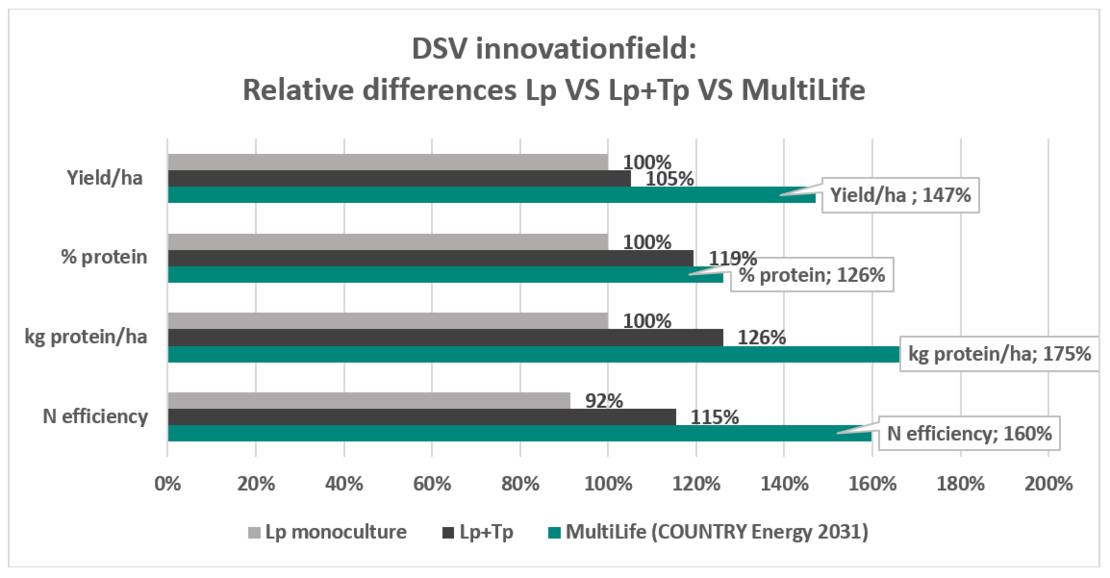The mixtures with Lp in the trial had a yield of 11,7 ton dm/ha at a fertilizer level of 235 kg N/ha. With average practical yields of 10 – 12 ton dm/ha this 11,7 ton dm/ha is an average performance. However, farmers often use higher fertilizer levels to achieve these yields. The clovergrass mixture achieved a slightly higher yield of 12,3 ton dm/ha.
The yield of the MultiLife mixtures are of a total different level. The MultiLife mixture “COUNTRY Energy 2031” achieved a yield of 17,2 ton dm/ha. This is 47% more as the Lp monoculture mixture.
The MultiLife mixture “COUNTRY Energy 2031” has a crude protein level of 18,8% and the Lp mixture had 14,9% crude protein. Relatively this is 26% higher. Thanks to the high yields and protein levels the crude protein production per ha is even 75% higher. Respectively 1344 kg crude protein/ha for the Lp mixture and 2348 kg crude protein/ha for COUNTRY Energy 2031.
In comparison to this, the differences between the MultiLife and the clovergrass mixture are slightly smaller, as the Red clover leads to a crude protein level of 17,8 % and a crude protein production of 1694 kg/ha.
Based on the protein yield also the nitrogen yield and nitrogen efficiency is calculated. The Lp mixture had a yield of 215 kg N/ha at 235 kg N being fertilized resulting in a efficiency of 92%. So almost all of the fertilized nitrogen was build up in the plants which were harvested. With a nitrogen yield of 271 kg N/ha, the clovergrass mixture achieved an N efficiency of 115 %.
The MultiLife mixture “COUNTRY Energy 2031” on the other hand was able to use extra nitrogen from deeper soil levels and from the air to reach a nitrogen yield of 462 kg N/ha resulting in an efficiency of 197%.
By doing a lot of research and testing, DSV is able to explain how these stunning results were possible. The right species and composition in the MultiLife mixtures strengthen each other so 1 + 1 = not 2 but 3!
Thanks to the different species (grasses, legumes, herbs) there is a big variability of root systems, which differ in depth and intensity. The different growth cycles ensure for growth during the whole season, which can be seen in the higher yields. At the moment a monoculture is growing slower at a certain time no other species will take over the growth and the total yield potential is lower. Especially in dry periods species-rich MultiLife mixtures lead to more robust stands through the intelligent combination of different root systems. For example, the taproot of the chichory in particular provides increased drought tolerance.
Protein is formed out of nitrogen. Via fertilizer nitrogen is brought into the system, but the allowed fertilizer levels are decreasing due to governmental restrictions. Partly dependent on the soil type a big part of the nitrogen is stored in the soil and the soil life. Deeper and more intensive root systems are also important at this point.
Dependent on the mineralization and the soil type a lot of nitrogen can become available. However, when the crop is only able to grow roots until a certain depth, all the deeper available nitrogen will not be available. At the place of roots there is soil life. These bacteria and organism in the soil bring life and associated nitrogen closer towards the surface resulting in all plants to profit from it.
Next to nitrogen deeper in the soil also the air contains for a big part out of free available and free costs nitrogen. Legumes like clovers are able to bind this nitrogen in cooperation with rhizobium bacteria at their roots systems.
These bacteria are going to work harder and bind more nitrogen at rising soil temperatures so as the mineralization process during summer and autumn. To keep converting this nitrogen into protein in the crop, enough growth of these crops is important. The deeper rooting species are able to keep growing even in dryer summers resulting in more nitrogen uptake.
In the end, how to use these COUNTRY MultiLife mixtures in the total farm plan?
As an example we take the situation in the Netherlands. Partly due to the derogation legislation and demands dairy farmers are having 80% grassland in their total farm plan. Use 60% of your farm plan for permanent grasslands with DSV COUNTRY Energy mixtures for high milk and milkprotein production.
Use another 20% for DSV COUNTRY Energy MulitLife mixtures 2030 and 2031, which can be used as “wellness” treatment for your soils resulting in high (protein)yields. These mixtures enhance the soil quality and soil life. Thereafter crops like maize and sorghum (the last 20%) will profit from this crop rotation in your farm plan.
Resulting in the so-called 60-20-20 farm plan.

